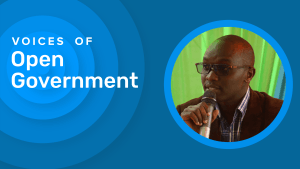How to Safeguard Good Governance Reforms during Leadership Transitions
During the 2025 OGP Africa and the Middle East Regional Meeting in Kenya, attendees raised a common concern faced by many OGP members—how can reformers protect and sustain open government reforms during periods of political transition? In this blog, John Maritim, Director of Economic Planning and Budgeting and the OGP Point of Contact for Elgeyo Marakwet County in Kenya, explains the risks posed by political transitions and provides concrete strategies to weather these changes.
Leadership transitions are one of the most uncertain times for citizens and the growing number of governance reformers. When national and local governments enter an election year, it is not surprising that citizens and reformers become anxious, awaiting the post-election governance preferences of the newly elected leaders.
In 2022, Kenya experienced a shift in leadership. During political rallies, promises for road construction, water supply, classroom buildings, and other physical infrastructure dominated candidates’ discourse, playing into citizens’ needs. But few promises focused, if at all, on good governance practices that the candidates would focus on if elected. When good governance came into the conversation, it lacked conviction and commitmentOGP commitments are promises for reform co-created by governments and civil society and submitted as part of an action plan. Commitments typically include a description of the problem, concrete action....
Traditionally, in low-middle income countries, politicians’ “commitment” to development revolves around physical infrastructure—the physical, evidence-based projects that politicians believe can easily lead to their re-election. However, it’s difficult to prove the direct benefits of good governance ideals of openness, accountability, citizen participationAccording to OGP’s Articles of Governance, citizen participation occurs when “governments seek to mobilize citizens to engage in public debate, provide input, and make contributions that lead to m... More, and transparencyAccording to OGP’s Articles of Governance, transparency occurs when “government-held information (including on activities and decisions) is open, comprehensive, timely, freely available to the pub... More because they materialize over the long term. Without a proper institutional framework to implement physical projects while upholding good governance practices, navigating this conundrum is left to the discretion of officeholders.
Globally, successful examples of landmark infrastructure projects demonstrate the power of transforming communities. But amid such successes, little credit is given to the role of good governance by the leaders involved, leading to the question: Should good governance be left to the discretion of officeholders based on their personal preferences and temperaments?
Allowing newly elected leaders to pick and choose which good governance ideals to adopt is what fuels anxiety among reformers and civil society. The resulting uncertainty disrupts ongoing or planned reform agendas, significantly derailing progress and undoing gains already achieved.
When accountable governance gained traction in 2011 with the formation of the Open Government PartnershipThe Open Government Partnership (OGP) is a multi-stakeholder initiative focused on improving government transparency, ensuring opportunities for citizen participation in public matters, and strengthen... More (OGP)—a unique collaboration between government and civil society advocates—strides toward greater government openness were made, despite concerns during leadership transitions.
To alleviate fears during moments of uncertainty, there is a need for governments to institutionalize good governance practices to ensure they transcend regimes. This can be achieved by adopting strategies where sustained implementation will determine governments’ ability to carry forward openness and other good governance practices across different administrations.
Strategies to weather leadership transitions include the following.
- One responsible ministry: Designating good governance functions to a specific ministry or department will eliminate the temptation for governments to avoid assigning responsibilities on good governance and avoid a situation where no department takes responsibility for reforms. To further institutionalize the process, governments can designate a contact person and a good governance desk to guarantee continuity.
- Training public servants: Embedding a good governance curriculum into courses taught for public servants at schools of government and other educational institutions. This approach will entrench the ideals of good governance among public servants. Additionally, all induction content for newly elected politicians or appointed public servants should include openness and other good governance ideals.
- Key performance indicators: Integrating incentives in the public service reform agenda is critical. This can be achieved by incorporating openness and other good governance principles into the performance indicators of public servants’ measurement standards. When paired with rewards and recognition for top performers, this strategy can elevate the adoption and buy-in of good governance through internal competition and create a “win-win” situation for all stakeholders.
- Consolidating policy: Formulating and enacting relevant policies and laws can protect any clawback on reforms by incoming officeholders who, in the process of restructuring, may inadvertently derail reforms. These laws and policies, if accompanied by a dedicated budget line, will have long-term, positive impacts on the reform agenda.
- Best practice through resource allocation: Utilizing good governance performance indicators in the allocation of resources from the national government to local governments, and from local government to ministries or departments, will motivate institutions to sustain and elevate best practices, regardless of the personality of the new officeholder.
If implemented, the strategies have the potential to lead to smoother buy-ins, less resistance to change, and long-lasting change, irrespective of leadership transitions.
No comments yet
Related Content

Focus on the Reform. And the Reformer!
In this episode, learn how Elgeyo Marakwet County, Kenya applied open government principles to tackle the COVID-19 pandemic and the importance of recognizing the people behind the reforms in government…
Action plan – Elgeyo Marakwet, Kenya, 2025 – 2027

The Future is Open: OGP at UNGA
In September 2024, the Open Government Partnership and the Ford Foundation convened more than 60 global open government leaders from government, civil society, and international organizations for an OGP Leaders…


Leave a Reply